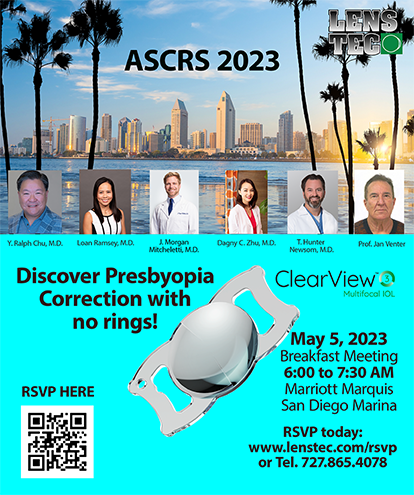This is the question that many cataract surgeons are asking about aspheric IOLs and the one we posed to leading experts for this month's issue. We ophthalmologists can easily appreciate the differences between monofocal and presbyopia-correcting IOLs by directly assessing UCVA, how frequently patients wear spectacles, night vision complaints, and patients' satisfaction. In contrast, we never know how much an aspheric IOL improves an individual patient's vision. Our cataract patients are satisfied whether we routinely use aspheric IOLs or not. Without measuring contrast sensitivity, we have no objective way to compare outcomes.
For example, Luther Fry, MD, of Garden City, Kansas, conducted a bilateral eye study with 100 patients in which he implanted a Tecnis aspheric IOL (Advanced Medical Optics, Inc.) in one eye and a spherical Acrysof IOL (Alcon Laboratories, Inc.) in the other.1 (As several of this issue's authors point out, a night driving simulation study of these same two IOLs demonstrated superior performance from the aspheric.2) Dr. Fry's patients understood that their eyes received different IOL models, and they were asked postoperatively about which eye saw better both overall and under low-light conditions. There was a trend toward their preferring the spherical IOL, but this was not statistically significant. There should have been an optical benefit with the aspheric lens, but apparently, most of these patients could not detect a difference.
Before the FDA approved the Tecnis in 2001, IOL surgeons were not at all concerned with spherical aberration. Today, we must join our refractive colleagues in understanding wavefront terminology and analysis. Even then, it seems that we still have more questions than answers. Do all spherical IOLs produce the same amount of spherical aberration? Is it better to have a little spherical aberration or none at all? Under what lighting conditions and with what pupillary sizes does spherical aberration matter clinically? Does having some spherical aberration enhance or reduce pseudoaccommodation and depth of focus? For how many patients would IOLs with negative spherical aberration worsen their optical aberrations? How much IOL tilt and decentration typically occurs in our patients? The central diffractive rings of the Acrysof Restor IOL (Alcon Laboratories, Inc.) demonstrate that the center of the capsular bag and the pupil are often misaligned. How does this discrepancy affect our effort to correct aberrations with IOLs? To better quantify the benefits of aspheric IOLs, we clearly need more head-to-head clinical studies.
As several of our contributors suggest, to truly minimize spherical aberration, we would need to measure and match that of the cornea and the IOL preoperatively. Would patients or payors understand the benefits enough to reimburse the additional time, instrumentation, and expanded IOL manufacturing that such a customized system would require? One paradox continues to bother me. If aspheric IOLs really improve contrast sensitivity that much, then multifocal IOLs must be worsening optical aberrations by a several-fold greater amount. If we are not overestimating the clinical benefit of aspheric IOLs, then we must be underestimating the optical drawbacks of multifocal IOLs. We cannot have it both ways.
Finally, I would like to extend my personal thanks and congratulations to my Co-Chief Medical Editor, John Doane, MD, upon his completing 5 remarkable years at our helm. His enthusiasm, vision, and leadership have made this publication an engaging forum for debating new ideas, challenges, and controversies. As impossible an act as John's is to follow, I look forward to the clinical insights, talent, educational creativity, and overall fun that Stephen G. Slade, MD, of Houston will bring to the party.


